Frequently Asked Questions
Chroma's engineering and service departments have exensive industry knowledge. In an effort to help our customers, Chroma has put together an FAQs section to better support our customers. Please check here for your question before calling in to Chroma. If you cannot find an answer to your question and issue, our customer service representatives and engineering team will be happy to assist you.
Contact info
Chroma East
734 Forest St.
Suite 500
Marlborough, MA 01752
» Tel: 978-461-2100
» Email: Sales
General
- Why do products need to undergo electrical safety tests?
- What does UUUU on the display mean?
- When is Safety Testing Required?
- What is Electrical Shock?
- What are the primary tests in Electrical Safety Testing?
- How do I select the correct safety test equipment?
- Is there a way to prevent operators from changing the test program?
- Is there any easy way for operators to access programs in memory?
- Why do I need a fast discharge circuit in an electrical safety tester?
- How do I ensure the test connection is OK?
- Why do the electrical safety test operators need more Training?
- Is there any special requirement for Test Environments?
- What is lock recall?
Products need to meet electrical product safety test standards to ensure that they are safe before reaching the end-user. Products are regulated to protect consumers and operators from electrical shock hazards. Shock hazards exist when a consumer or operator is exposed to a potential voltage and current, with respect to earth ground. This can lead to electric shock, which can be very dangerous and life-threatening. Electrical safety tests do not take a long time to perform, and greatly reduce operator and consumer risks.
The measurement range for the test has been exceeded. For IR this typically means the measured value is greater than 50Gohm. For Hipot it means the range or max current of the unit has been exceeded.
Safety testing is required during manufacturing. Products must pass these safety tests before being made available to the end-user. Manufacturers of electrical products need to ensure that products do not present a hazard to users. These hazards could include voltage or current leakage. To ensure product safety, manufacturers must test their products to determine if they meet minimum safety requirements, as defined by specific regulatory standards ( standards are dependent on type of product).
Electrical shock is caused by current passing through the human body. Studies have shown that the human body can feel the sensation of an electrical shock with as little as 1.0ma of current. Since the human body is not a fixed resistance, the voltage required to produce 1.0ma of current can vary greatly based on the minimum impedance of the human body under various conditions (some models use a human body resistance value of 1K ohms up to 100K ohms).
There are four primary electrical safety tests for products: Dielectric Withstand (Hipot), Isolation Resistance, Leakage Current and Ground Continuity.
The first step in selecting safety test equipment is to understand your basic requirements. It may be the safety standard your product needs to comply to. The appropriate safety test equipment is not only selected in accordance with safety standards but considers functional product requirements, cost and efficiency. For example auxiliary accessories like HV Guns, fixtures, and software control can increase test efficiency. It is our recommendation to give us a call to help select your equipment.
Yes, all of QuadTech’s Hipot testers have a function called Key lock. When this is enabled the test programs cannot be modified. Keylock is password protected.
Yes, enable keylock with lock recall set to NO. This will place the recall button on main testing page.
Almost all devices under test (DUTs) are equipped with a charged capacitor when testing DC Voltage. To avoid electrical hazards, it is necessary to discharge the capacitor to a regulated voltage value at the end of the test. However, the higher capacitance value, the longer it takes to discharge. This directly impacts the efficiency of the process. Our safety test equipment includes a fast and reliable capacitor discharge circuit to ensure production efficiency and safety.
The Open Short Circuit (OSC) function can help ensure a good connection. A hipot test can produce a false pass if the high voltage cable between the DUT and hipot tester is broken or not connected. This means that if the connection to the DUT is open, a product could pass when it should have failed. The OSC function also checks to determine if there is a short during testing, which could put the instrument itself at risk. Using the OSC function helps to ensure you are passing good product and protects the equipment.
It’s important for electrical safety test operators to have training because they need to be aware of the hazards of electrical testing and the testing environment. Not all test equipment has safety features to protect operators. Therefore, it is vitally important for operators to understand the test procedures. At a minimum, operators should understand the effect of an electrical shock to the human body, precautions to take in order to avoid getting shocked during the testing process, and how to handle an emergency.
There are a variety of standards companies may need to conform to in order to maintain their test environments. For example, standards such as UL, IEC and EN include chapters on safety regulations. These safety regulations may include the grounding status of the test area (personnel, instrument, DUT position), equipment marking (especially for “dangerous” items), and the electrical insulation capability of various test equipment. Many electronic appliances, technology products, household appliances, mechanical tools or other miscellaneous equipment are tested to the IEC 61010 Standard.
Lock Recall is part of the key lock function. When set to Yes, the ability to recall memory locations is locked. When set to NO, the operator is able to recall different test programs in memory, however they will not have access to modify the programs.
AC/DC Dielectric Withstand Test (HIPOT)
- What is a Dielectric Withstand Test?
- How many types of isolation are there in Safety Standards?
- What are the measurement ranges for Hipot?
- Why do we need real current function in AC Hipot test?
- Is the measurement compared to the high limit during ramp? Why is my test failing during ramp?
- Does my QuadTech Hipot automatically discharge?
- Why do we need ramp time in DC Hipot test?
- What is Start Wait?
- Why do we need fall time in Hipot test?
- What is flashover (ARC)?
- What is ARC Detection?
- Why do we need Auto Gain Compensation?
There are many synonyms for dielectric withstand, such as high potential and hipot test. A Hipot test is one of the most common safety tests being seen. The main purpose of hipot test is for testing the insulating capability of the DUT (Device under Test). When the equipment is operating, apply a high voltage to the test point to test whether insulation breakdown or electrical flashover/ARC occur.
The insulation is divided into four types; Basic, Supplementary, Double and Reinforced.
For AC Hipot, <3mA is the low range, >3mA to max current of unit is the high range. For DC Hipot,<0.3mA is the low range, 0.3mA - 3mA is the mid-range and >3mA to max current of the unit is the high range.
The real current test is a measure of the resistive current component of the device under test. The resistive component is attributed to the resistance of the device’s insulation.
If RAMP JUDGMENT is set to ON, the high limit will be compared during ramp and the test will fail if the high limit is exceeded. If RAMP JUDGMENT is set to OFF, the high limit will not be compared during ramp. A ramp failure with RAMP JUDGMENT off is typically due to the leakage current exceeding the measurement range.
Yes, the unit measures the voltage at the output and will keep the danger light on if voltage >50V is present.
DC hipot tests usually need to add ramp time because most DUTs have capacitance, and this causes charging current to be generated. For charging current, steady ramp time is needed for buffering.
The Start Wait time is a delay time for Ground Bond – after a connection to the device is made and before current is applied to begin the ground bond test. This feature is beneficial for probing. For example: If a 2 second start wait time is programmed, once the Continuity between high and low GB connections is made, the unit waits the 2sec programmed start time then applies current to the DUT.
After the hipot test the DUT will need to discharge, therefor requiring a period of time for discharging. It will show a warning until it is safe for the operator to touch the equipment.
Flashover is an electrical breakdown of a gas that produces an ongoing plasma discharge, resulting from a current flowing through normally nonconductive media such as air. Vasily V. Petrov, a Russian scientist who discovered it in 1802, first described the phenomenon.
During a Hipot Test, steady state current is monitored. If a high frequency transient is found that persists for longer than a specified time, which may be as short as 10ms, the arc detection circuit interprets this as an arc. If the magnitude of the arc exceeds the limit set, the test will immediately alarm and terminate. Arc detection alarm differs from other failure alarms by beeping, where other failures have a steady buzz.
Auto Gain Compensation corrects and maintains the output voltage at a specific level.
Ground Bond Testing
- What is Ground Bond Testing?
- Why is my unit showing GB Open? How do I turn it off?
- What is the difference between Ground Bond and Ground Continuity?
Ground protection testing consists of two methods: Ground Continuity test (GC) and Ground Bond test (GB). The purpose of ground protection testing is for protecting users from electrical hazards as touching equipment when unsuitable current is created and flows to the earth.
This is a function of Start Wait. To disable GB Open, set Start Wait to OFF.
Ground Bond and Ground Continuity both apply a current and measure the resistance of the ground connection within a Device Under Test (DUT). The current used for Ground Bond is higher 1A � 40A, where as the current used for Ground Continuity is 100mA.
Insulation Resistance Testing (IR)
- What is Insulation Resistance Test?
Insulation resistance test and DC withstand test are very similarity, apply DC voltage (50~1000V) to two points of connecting for judging good and no good product. Insulation resistance test is nondestructive test and can detect if insulation is good. Some regulations require insulation resistance testing first, then withstand testing. When an insulation resistance test doesn't pass usually withstand voltage test will also fail.
Leakage Current Testing (LC)
- What is Leakage Current?
- What are the different classes of products that are tested for leakage current? (Class I, II)
- How many types of leakage current tests are there?
- Why are leakage current tests so important in Medical Equipment Safety Standards?
- What is earth leakage current?
- What is Enclosure / touch Leakage Current?
- What is patient leakage current?
- What is Patient Auxiliary Leakage Current?
In low voltage electronics, leakage current is any current that flows when the ideal current is zero. In medium and high voltage applications, leakage current is the flow of current through the body or over the surface of an insulator. Leakage testing is done while the device under test is powered on.
There are two classes according to the IEC standards.
CLASS I indicates anti-shock protection of the product. It not only depends on basic insulation, but also includes a grounding method.
CLASS II indicates anti-shock protection of the product. It not only depends on basic insulation, but also includes an additional precaution. For example, double or reinforced insulation but without grounding for precaution.
There are several different types of leakage current: Earth Line Leakage, Touch/Chassis (Enclosure) Leakage, Patient Leakage and Patient Auxiliary Current.
Leakage current tests are important in Medical Equipment Safety Test Standards because the level of leakage current helps to verify if the equipment is electronically safe for human beings or not. Medical electrical equipment can cause electrical hazards to patients and operators if not properly tested.
The leakage current from all earthed parts of the product. The current flowing from the mains supply through or across insulation into the Protective Earth Conductor.
Leakage Current from the enclosure or other parts, excluding applied parts that are not connected to a protective earth conductor.
Patient Leakage Current is the current flowing from every individual part of the applied part back to Earth or the current flowing from an unintended appearance of a voltage on the patient back to an F-Type Applied Part.
Current flowing between patient connections. This current is not intended to be there to produce an effect in the patient.
Service and Support
- What do I need to do to return an instrument for service or calibration?
- How often should my unit be calibrated?
- How long does the calibration service take?
- Can anyone calibrate my unit?
- What calibration service do you provide?
- Can I calibrate my unit myself?
- If I modify my instruments, will that void my warranty?
- Can QuadTech units be upgraded?
- Do you offer expedited service?
- Are data readings available?
- Do you offer loaner units?
- Is there a charge for the loaner units?
- What specifications does a QuadTech hipot tester meet?
- Do "hi-pot testing", "hipot testing" and "hy-pot testing" mean the same thing?
- What are the quality specifications of a QuadTech LCR meter?
- What are the quality specifications of QuadTech ESR meters?
- What do ESR and LCR meters measure?
You can obtain an RMA# online. This number, when placed on the outside of the shipping package, will speed processing at our Service Lab and will serve as a reference number for the time your unit is at QuadTech.
QuadTech recommends most units be calibrated once per year or anytime any service work is done to the unit. If a unti is under heavy work loads (12-14 hours a day, 7 days a week) then we recomment a 6-9 month calibration cycle.
It varies from model to model but on an average of 3-5 days from receipt of the unit at QuadTech.
There are other calibration services out there that can service your unit. Having anyone other than QuadTech authorized service technicians work on the unit will void any and all warranties on the unit. Also we do not give out our calibration procedures, so to have the unit calibrated to its original tolerances the unit should always be calibrated by QuadTech.
We provide complete calibration services for QuadTech products traceable to NIST.
We provide a calibration verification procedure for some instruments in the operator manuals but some of the units can only be calibrated by us.
Yes. Any non-factory modification of the unit will void your warranty.
Some of the units can be upgraded and the cost varies depending on the upgrade being preformed and the model of the unit. Please contact a customer support representative to discuss the options available for your unit.
Yes we do offer expedited service for an additional fee. This will cut calibration lead times in half and repair quotes to 3 days.
Yes - Before and after data readings as well as after data only readings can be provided for an additional charge. Note that for the 1700 models only after data is available.
Yes we do have a limited number of loaner units available.
Yes. It is a one time charge for the loaner unit while your unit is being serviced. One requirement is that the loaner unit must be returned to QuadTech as soon as your unit is returned to you.
A QuadTech hipot tester meets and exceeds the CE mark evaluation specification.
Yes, this does create some confusion, but they all reference the same type of hipot tester (which, of course, can also be spelled 'hi pot tester' or 'hy-pot' tester).
Any QuadTech LCR meter meets the CE mark specification.
All QuadTech ESR meters meet the CE mark specification.
An LCR meter measures inductance (L), capacitance (C), and resistance (R) and an ESR meter measures the equivalent series resistance. Visit the Power Glossary to learn more about specific test and measurement equipment and related terms.
LCR and Milliohmeter
- Are instruction manuals available for QuadTech LCR Meters, milliohmmeters and megohmmeters?
- Are Leads included with LCR Meters and Milliohmmeters?
- Are fixtures and leads available for connection to surface mount components?
- Are Manuals still available for the GenRad/QuadTech 1657, 1659, 1689 and 1693?
- Does QuadTech still have information on older GenRad products?
- What software is available for connecting LCR Meters to a PC?
- What is the password override for 7600?
- What is the password override for 7400?
- What is password override for 1920 and 1910?
- What are calibration passwords for 1900, 7400,7600?
- How do I reset a 1750 LCR Meter?
- Are longer Kelvin cables available for LCR Meters?
- What is the part number for the mating plug for the handler on the 1730T LCR Meter?
- What is the part number for the mating plug for the handler on the 7400, 7600 and 7600 Plus LCR meters?
- How often should batteries be replaced on the 7400 and 7600 LCR Meters?
- Do QuadTech’s LCR meters have USB ports?
- The test setup on my 1715/1730 changes when I power it down, how do I set the default setup?
Instruction Manuals for QuadTech LCR meters, milliohmmeters and megohmmeters can be downloaded from the QuadTech Manuals section of Chroma Systems Solutions' online store. These are available at no charge.
1715, 1730T, and LR2000 LCR Meters all include 1 meter Kelvin Cables. Leads are optional on 1900 Series and 7600 Plus LCR meters.
Yes, The 1700-05 and 7000-05 Tweezers and 7000-07 Chip Component Test Fixture are available for testing SMD components and can be used with all QuadTech LCR Meters. Tweezers and Chip component test fixtures will accept SMD devices with width: 0.5-10mm, and length: 0.1-8mm generally for SMD components 0201 (0603metric) or larger.
Yes, the GenRad/QuadTech Digibridge LCR Meters product lines were sold to IET Labs. IET Labs still sells and support these products. Instruction manuals are available on their website.
The majority of GenRad products are now support by IET Labs. This includes Decade resistors, capacitors, Digibridge products and 1863/1864 Megohmmeters. There are also a number of individuals on EBAY that sell manuals for older GenRad products. This does not represent an endorsement by QuadTech, GenRad or IET Labs however you can find one seller here.
QuadTech offers Software Wizards for the 1715, 1920 and 7600 Plus LCR Meters. The wizards can be download at no charge from QuadTech's download center page. The Wizards work with RS232 interface and allow configuration of the LCR meter from a GUI and logging of data to a file in csv format.
7600-01
7400-01
242671
1900225, 7400225, 7600225 respectively
[PROG][SHIFT]{SPECIAL][9][=][1][9][9][9][1][0][7][5] Power off and on.
1700-07 Kelvin cables are two (2) meters long.
QuadTech part number 329210 50-pin micro-ribbon plug.
QuadTech part number 320033 36 pin micro-ribbon plug or centronics plug.
QuadTech recommend replacement annually to prevent lost of setup data. If battery gets low the LCR meter will power up with numerous error messages including “Bad setup data read from memory”.
The 7600 Plus has standard USB 2.0 host port for storage of setups and data to a memory stick. QuadTech also offers a USB to RS232 Adapter cable QuadTech part number 630250 which can be used with any of QuadTech’s LCR meters, milliohmmeters and megohmmeters for connection to a USB port on a PC.
Once all parameters are programmed press the system key this will save these settings for power on.


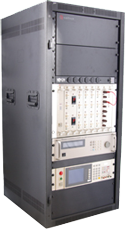


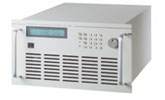
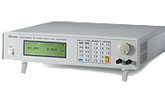
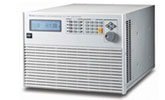
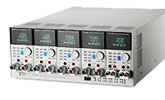
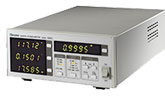
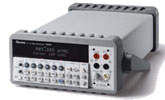




Follow Us